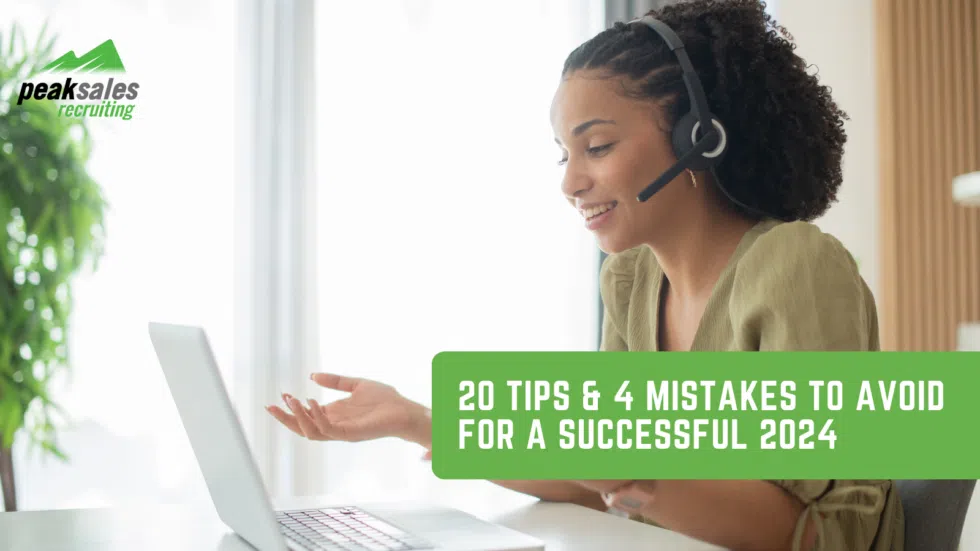Top sales leaders know there’s a difference between achieving one sales win and winning sales over time. The first can be a matter of making enough offers and, by chance, closing a deal. The second is always a matter of strategy, commitment to a winning sales process, and investing in continual improvement.
The twelve steps to winning sales you’ll find in this blog are a repeatable process we have gathered and refined from our work with thousands of companies.
Whether you’re a seasoned sales pro looking to up your game or a budding salesperson eager to master the art of persuasion, this roadmap is for you.
12 Steps to Winning Sales
Step 1: Set and Monitor Goals In Your Sales Pipeline
Tracking your sales conversion rate alone won’t motivate you to build a winning sales record. Before you start selling, set clear and tangible goals for yourself at various stages in your sales pipeline. Set goals and track metrics like how many calls you make daily, how many demos you give per week, and how many contracts you propose monthly.
The easier it is to see that you’re making progress, the more likely you will feel inspired to continue.
Step 2: Know Your Competitors
Equip yourself with thorough industry knowledge to maintain a competitive edge. Go beyond knowing that your competitors sell a similar product and learn how they are marketing, what selling techniques they use, how accessible their sales team is, and how they deliver their services.
Observing your competitors can help you create a pool of potential leads and inspire you to fill in the gaps in your competitors’ offerings.
Step 3: Set and Monitor Goals In Your Sales Pipeline
Tracking your sales conversion rate alone won’t motivate you to build a winning sales record. Before you start selling, set clear and tangible goals for yourself at various stages in your sales pipeline. Set goals and track metrics like how many calls you make daily, how many demos you give per week, and how many contracts you propose monthly.
The easier it is to see that you’re making progress, the more likely you will feel inspired to continue.
Step 4: Study The Solution You’re Selling
Intimate knowledge of the solution you’re selling, whether it is a product or service, can become your sales superpower. Study your product extensively so that you can answer any question a prospect may have.
A few key things to study about your solution are:
- The core benefits it provides to your prospects. To avoid over-selling your company or the solution features, stay focused on the results your customers can get by using your product or service.
- How it compares to competitors’ solutions. Your solution likely has advantages and disadvantages. Know how to position your strengths to outweigh your weaknesses and make your solution the better choice.
- The flaws of your solution. Ignoring the flaws of your solution is a mistake. Inevitably, a prospect will point them out or ask about them. Be prepared to offer clear and compelling information about your flaws. Consider how you can positively frame them while remaining honest about your solution’s limitations.
- The features of your solution. This is crucial for demos and deeper product discussions with prospects. Keep in mind that you don’t want to lead with features, though. Prospects will be more impressed with what your offer can do for them than what your offer is.
Step 5: Show You Care About Your Customer
When you pay attention to your prospect, you can understand them better and build a strong customer relationship. Ask questions, get to know your prospect’s needs, and don’t interrupt them when they’re speaking. Seek clarity and always affirm what your prospect is sharing with you. Pay attention to cues that signal discomfort in the process, as you never want your prospect to feel pressured into sharing with you.
Aim to make your prospect feel heard by deeply listening and reflecting back to them the problem they are trying to solve until you understand their needs and challenges better than they do. Remember to focus on what makes each customer unique; don’t feed them a generic script.
Step 6: Be Prepared to Overcome Common Objections and Obstacles
Overcoming objections should never be about forcing customers into a purchase they don’t want to make. Instead, overcoming objections should be an extension of step 5 in our winning sales process — caring about your customers.
Most objections you’ll encounter in your sales cycle are questions disguised as negative statements about your product, excuses that put off decision-making, or reasons the prospect can’t buy at all or buy right now. As long as you’ve determined that the prospect is a qualified fit for your product or service, skillfully answering these objections should result in increased trust and, of course, a closed sale.
Take time to think through the objections you commonly hear and build a stockpile of proven responses to sell more efficiently.
Step 7: Keep Your Promises for Long-Term Sales Success
A common mistake of inexperienced salespeople is making promises to close a sale but then being unable to follow through. While this can create a sales win in the moment, it won’t lead to winning sales over time. Broken promises erode customer confidence and lead to a damaged brand reputation.
The best strategy for keeping promises is to underpromise so you can easily over-deliver. For instance, if you promise a customer five-day delivery but deliver in two days, they’ll be pleasantly surprised and delighted. If delivery takes five days, they’ll still be perfectly happy with your service because you’ve set and met their expectations.
Know your limits and work within them.
Step 8: Ask For Referrals
Even with heaps of technology, cutting-edge marketing strategies, and the best cold calls you can possibly imagine — nothing creates sales wins like a referral. Prospects will be much more engaged in the sales process if they come to you through a recommendation made by a trusted contact in their network.
For this reason, it is imperative that you ask for referrals after every positive sales interaction. Positive sales interactions may or may not end in sale, but they all end in a favorable relationship being established between the salesperson and the prospect. Referrals might come from within another division of a prospect’s company or from their external network, and it can be helpful to remind your prospect of these various referral sources when you ask for them.
Step 9: Ask For Feedback on Your Sales Performance
At the end of each sale, have prepared questions you can ask your customers to evoke feedback. People respond best to direct questions rooted in curiosity — i.e., when there’s no ‘right’ answer or adverse consequences to their response. Depending on the client and your current goals, you could ask about your initial outreach, demo, or final sales proposal. Gathering honest feedback is one of the best ways to refine your understanding of your target market, product, and sales strengths.
Positive feedback will reinforce your sales skills, while negative feedback will shed light on where you can improve — any good sales representative welcomes both.
Step 10: Improve Your Next Sale
Richard Branson said, “Failure is only the end if you decide to stop.” This is certainly true in sales. Review each sale — whether it was a win or a loss. Notice where in the sales process you could have been more prepared, proactive, and present with your prospect.
Check back in with the goals you set for yourself in step three. Which goals were you able to achieve? Which goals were challenging to meet?
As you collect data from each sale, make notes on your goals so you can adjust them to represent realistic achievements that challenge you enough to keep you motivated yet aren’t so out of reach that every sale feels like a failure. Take what you’ve learned and apply it to your next sale.
Step 11: Know Your Customer Before Making Contact
Your ideal customer will usually have a social presence. Spend some time getting to know their online profile before making a call or sending an outreach email. Knowing your prospect beyond their name and title will allow you to have more personalized engagements.
Step 12: Expand Your Sales Network
Having a large network of sales professionals can help you win more sales and create meaningful relationships. Having a large network increases your exposure to the market. Whether you’re looking for prospects or to connect with expertise on a certain topic, individuals in your sales network will be able to help.
Having the right sales representatives on your team ensures that your company and customers get the dedication they deserve. We’re here to help you on your journey toward sales success so you can win more sales with top industry talent. Contact us today to discuss your hiring needs.
Related posts
close relpost-thumb-wrapper
Latest posts by Eliot Burdett (see all)
- 31 Must-Know Sales Follow-Up Statistics for 2024 Success – December 21, 2023
- 7 Success Characteristics That Define Top Performers – December 19, 2023
- 5 Reasons Your Top Employees Quit (Stop Doing This to Stop Them Leaving) – December 14, 2023





